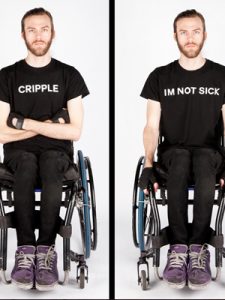2016 :: UNFIXED.2
ANAT’s 2015 partnership with Access2Arts (AUS), Unlimited (UK) and Watershed (UK) on Unfixed – a residency which invited ten Australian and UK Deaf and disabled artists to investigate the determination of bodies as ‘disabled’ / ‘abled’ – was followed up in the UK.
For participant Daniel Savage’ (as for many of the artists), Unfixed had been his first experience of a professional arts residency, and “one that acknowledged that lived experience of disability was an inherent part of our practice and actively encouraged creative exploration of its interaction with technology was more than I could have hoped for”. Most valuable, for him, was “the interaction with such a diverse group of disabled artists in an environment that supported critical discourse”, as in Australia “the tyranny of distance often forces disabled artists to work in isolation”.
Daniel had also found that the residency “forced me to step back and reflect on my own practice, to critique both the content of my work and the manner in which I made it accessible to my audience. Since then my work has engaged more experimentally with the idea of access and how it can be used as creative driver which opens artwork to new audiences, rather than being tacked on at the end.”
In the UK-based Unfixed 2.0 the Australian artists joined their English counterparts in London for the 2016 Unlimited Festival, then travelled to Watershed in Bristol to undertake a week-long Creative Development Lab. For Daniel this follow-up “built on everything from the year before”. By showing him “what opportunities were out there, what could be achieved with the right support and funding and how audiences will embrace work by disabled artists when given the opportunity”, it set a benchmark for “how disability arts can be a thriving part of the broader arts community.”
Since Unfixed Daniel’s own practice and ambition have grown, and he has also taken an active role in advocating for access, inclusion and representation of disability arts across the sector. For him the residency “stood in stark contrast to the inaccessibility of the broader Australian art world”, and his discussions with other artists “laid bare my own privileged position”. Realising that he had both the opportunity and responsibility to use this privilege to speak out, Daniel has gone on to work with local festivals and national institutions, and speak to arts organisations and government bodies on the importance and value of disability arts and inclusion, holding up Unfixed and Unlimited as examples of best practice.
Images: No offense, but… 1-16 (of 18), 2014. Inkjet prints, 50 x 70cm
Daniel – Quadraplegic / Will you ever get better?
Aoife – Mental illness / Can’t you just take a pill?
Cam – Transgender / You were born a girl right?
Troy – Gay / When did you admit you were gay?
Bec – Lesbian / Who is the man in the relationship
Andy – Mixed race / Halfies are always hot
Read Daniel’s reflections on Unfixed…
“For me and a lot of the other artists Unfixed was our first experience of a professional arts residency and having one that acknowledged that lived experience of disability was an inherent part of our practice and actively encouraged creative exploration of its interaction with technology was more than I could of hoped for.
The most valuable thing I got from Unfixed was the interaction with such a diverse group of disabled artists in an environment that supported critical discourse. As a disabled artists in Australia, the tyranny of distance often forces you to work in isolation and unfixed showed me that there was strong emerging community in Australia and overseas by exposing me to my peers.
The residency also forced me to step back and reflect on my own practice, to critique both the content of my work and manner in which I made my work accessible to my audience. Since then my work has engaged more experimentally with the idea of access, and how it can be used as creative driver, opening art work to new audiences, rather than tacked on at the end.
To follow it up with Unfixed 2.0 at the Unlimited festival in London and at the Watershed Pervasive media studio in Bristol built on everything from the year before.
It showed me what opportunities were out there, what could be achieved with the right support and funding, how audiences will embrace work by disabled artists when given the opportunity. It set a bench mark for how disability arts can be a thriving part of the broader arts community when given the opportunity.
Since Unfixed not only has my practice and ambition grown, but I’ve taken an active role in advocating for access, inclusion and representation of disability arts across the sector. The residency stood in stark contrast to the inaccessibility of broader Australian art world, and my discussions with other artists laid bare my own privileged position, and that I had both the opportunity and responsibility to use that privilege to speak out.
I’ve since gone on to work with local festivals and national institutions and speak to arts organisations and government bodies on the importance and value of disability arts and inclusion holding up Unfixed and Unlimited as prime examples to strive for.”
 Back
Back